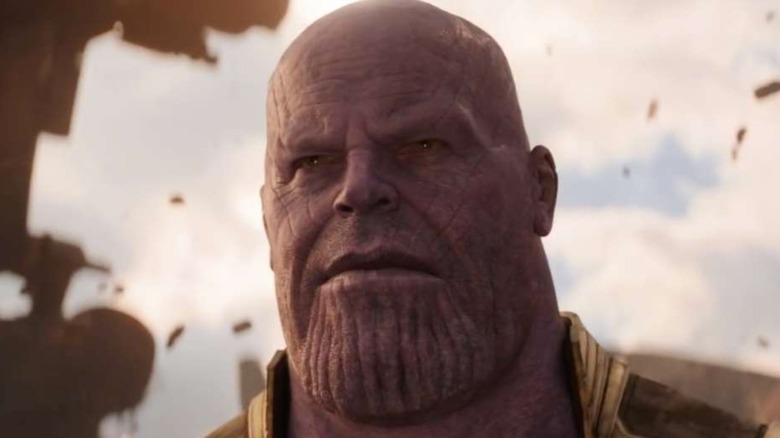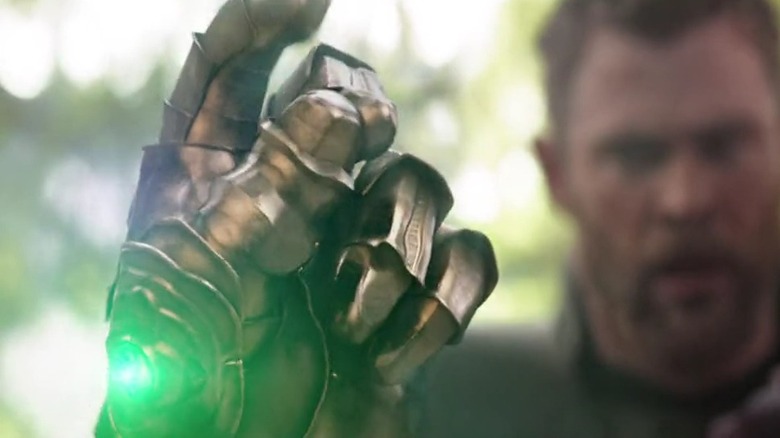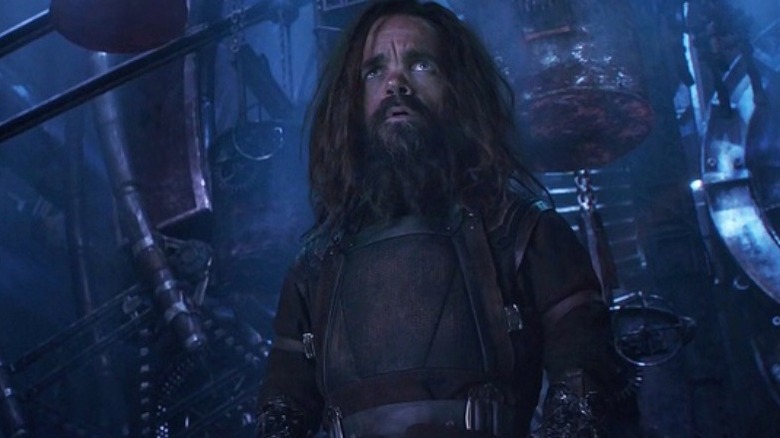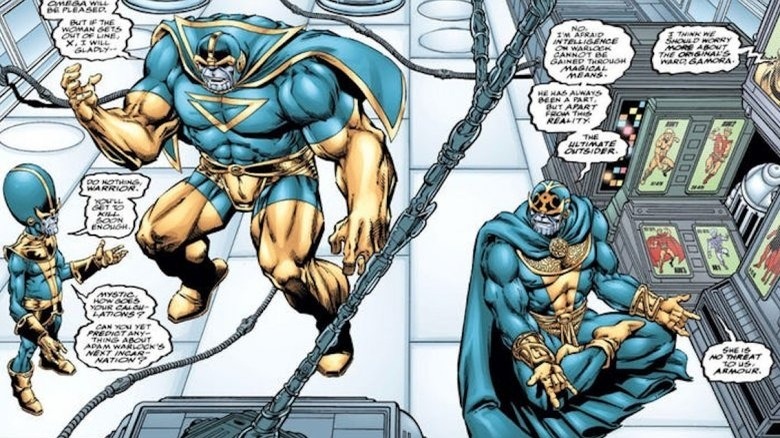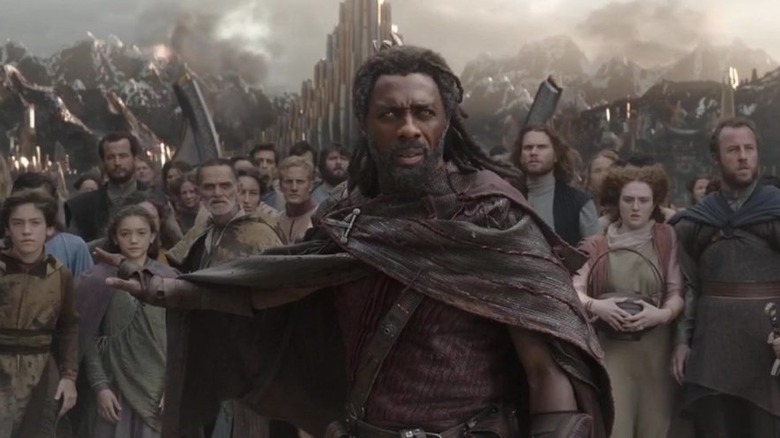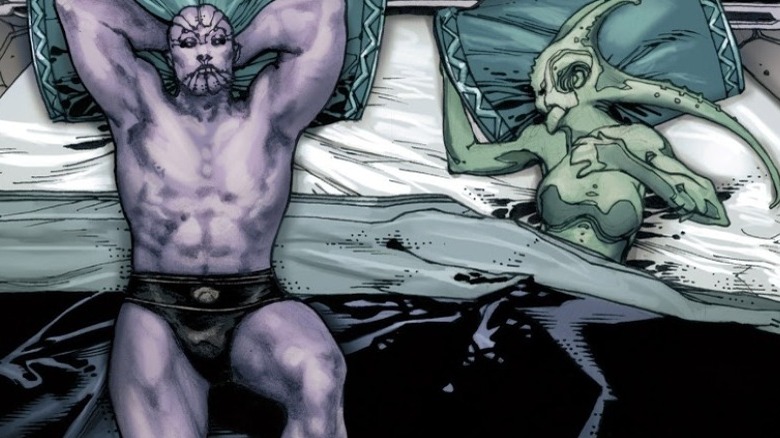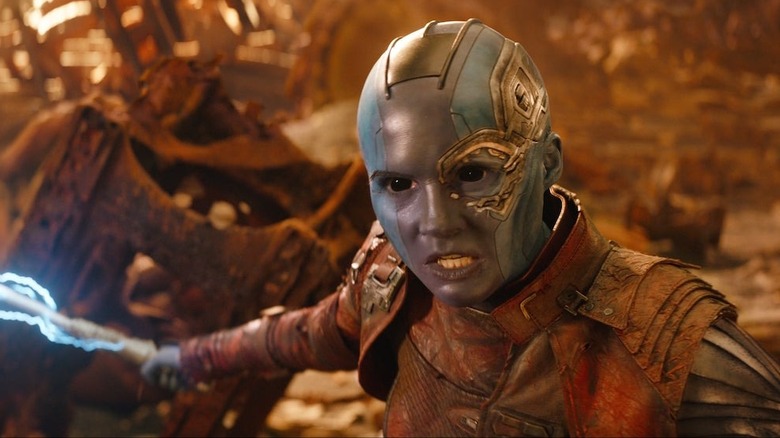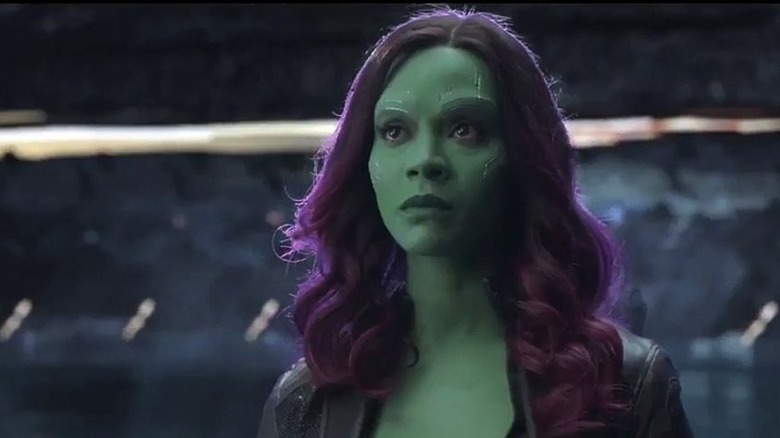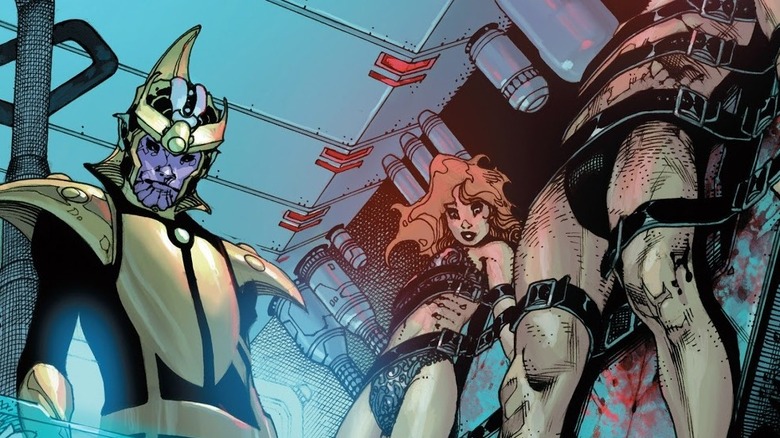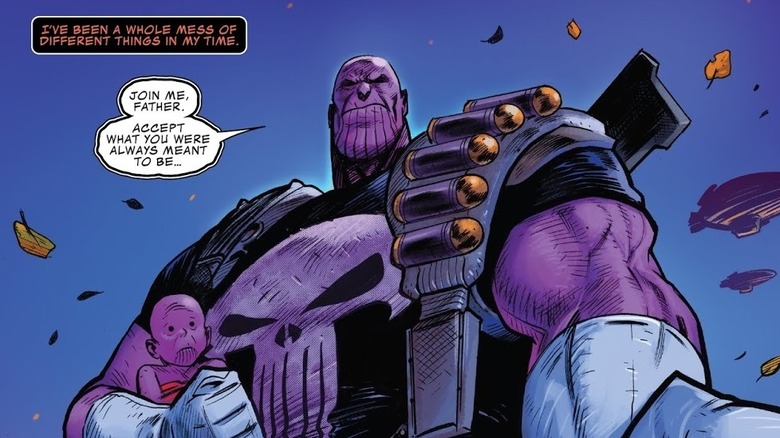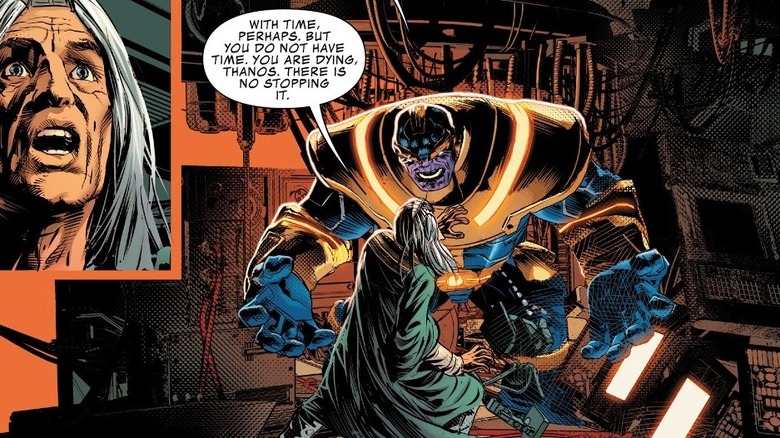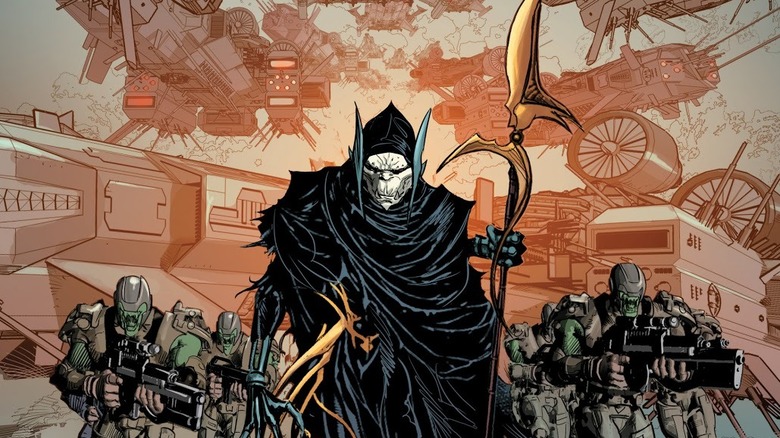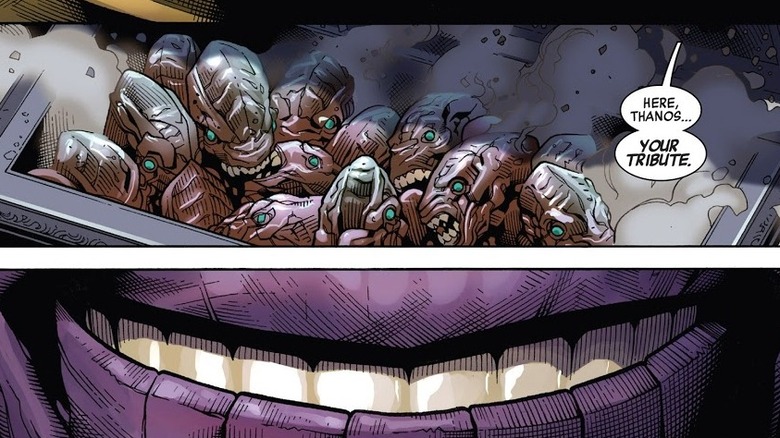The Worst Things Thanos Has Ever Done
First appearing in 1973's "The Invincible Iron Man" #55, Thanos has since become known as the genocidal villain who wipes out half of all life in 2018's "Avengers: Infinity War." Even after his defeat in 2019's "Avengers: Endgame," however, some fans still argue that Thanos is in the right.
There's a major problem with this outlook. To believe Thanos is justified in killing half of all life in the universe, you must first take his motivations at face value, and believe that all he's ever truly wanted is universal harmony. Yet almost everything he does — whether you're talking about the Thanos Josh Brolin plays in Marvel's films, or the version Jim Starlin created for the comics — proves that harmony does not have a home in the Mad Titan's heart.
Thanos is a brutal sadist and — on the screen and in the comics — a mass murderer of galactic proportions. His motivations are far from pure, and his selfishness knows no bounds. Even those few beings he feels affection for, including his family, are the victims of his cruelty. Need proof? These are the absolute worst things Thanos has ever done.
The snap
In both the comics and the films, aided by the combined might of the six Infinity Stones (or Infinity Gems, in the case of the comics), Thanos kills half of all life in the universe with a snap of his fingers.
In the comics, he does the deed in 1991's "Infinity Gauntlet" #1. While cosmically attuned characters like Doctor Strange and the Silver Surfer are already aware of Thanos' cruelty, the disappearance of half the world's population is what alerts most of Earth's heroes to Thanos' machinations. Does Thanos do this to further his purported goal of universal balance? Nope. He offers the slaughter as a gift to Mistress Death, in the hopes of wooing her.
Then there's the snap as depicted in "Avengers: Infinity War," which has much more devastating effects. While the dead of the comics' "Infinity Gauntlet" storyline are resurrected by the end of the series, it takes five years for the Avengers to bring back the victims of Thanos' snap. "The Falcon and the Winter Soldier" shows us just how deeply Thanos' actions harm Earth's political, economic, and social stability. And of course, what happened on Earth happened on every inhabited planet in the universe. Who knows how much turmoil the snap and the subsequent blip cause on countless alien worlds?
The Nidavellir massacre
When Thor, Rocket, and Groot travel to Nidavellir in "Infinity War," it's in the hopes that Eitri the Dwarf will be able to forge Thor a new hammer with which he can defeat Thanos. Unfortunately, upon arrival, they learn Thanos has already been there, though we don't know exactly when. All we know is that at some point, Thanos and his forces forced Eitri to forge the Infinity Gauntlet. Once Eitri's work was complete, Thanos murdered all the other Dwarves. As Eitri recalls, Thanos told him, "Your life is yours, but your hands ... your hands belong to me." He proceeded to encase the master craftsman's hands in metal, to keep Eitri from becoming a threat to his power.
On Nidavellir, Thanos is not only murderous — he breaks his own rules. Rather than killing half of Nidavellir's people, he murders all of them but one, effectively wiping out the entire race (unless the MCU's Dwarves have another hideout somewhere). He leaves Eitri alive, to suffer the memory of his people's end. As if that weren't cruel enough, he takes away the survivor's ability to do what he loves most.
It's all needlessly brutal, and has nothing to do with Thanos' supposed goals of universal balance. He could have left more Dwarves alive so they'd have a shot at repopulation, like other worlds he ravages. Or he could've killed Eitri, to spare him the experience of lingering in shame and misery. But he does neither.
His clones almost destroy the universe
Thanos' inherent malevolence is so potent, he threatens all life in the universe even when he doesn't mean to. Consider the Thanosi, who are introduced in the 2002 series "Infinity Abyss." In "Infinity Abyss" #3, Thanos explains to Gamora that he once created replicants of himself he calls a "blend of android, clone, and mystical doppelganger." Some Thanosi have powers similar to potential enemies, to help Thanos learn their weaknesses. For example, bulbous-headed X has psychic powers similar to those of Professor X, while Warrior is based on Gladiator, leader of the Shi'ar Imperial Guard. The most dangerous of them all is Omega, who Thanos originally designs to be a rival to the world-devouring Galactus.
In "Infinity Abyss" #5, the ancient being Atlez unintentionally unleashes the Thanosi. Atlez is a multiversal custodian nearing the end of his life, without any means of contacting his successor. Intending to free only one of the Thanosi in an effort to contact the hero Adam Warlock, Atlez instead frees them all. Due to what Thanos calls his "nihilistic personality phase," the liberated Thanosi set about destroying the universe. Thankfully, they are ultimately thwarted by the unlikely alliance of Thanos, Adam Warlock, Gamora, Doctor Strange, Captain Marvel (not Carol Danvers, but Genis-Vell), and Spider-Man. But chalk this one up as yet another instance of Thanos almost blowing up all of existence.
He needlessly slaughters Asgardian refugees
In the opening moments of "Infinity War," Ebony Maw calls the violence Thanos and his Black Order unleash upon the Asgardian refugee ship a "privilege," preaching to the dying that "the universal scales tip toward balance" because of their deaths. Half the refugees are allowed to escape the ship before its destruction. Later, Gamora explains that this is very much in line with how Thanos used to operate, before his quest for the Infinity Stones. Back then, the Titan went about his work piecemeal by invading one planet at a time and slaughtering half its population.
While some Asgardians and escaped Sakaaran gladiators were always going to die in Thanos' attack no matter what happened, murdering half of them does nothing to further Thanos' purported goals. The Asgardian people have already been greatly reduced in number by the events of 2017's "Thor: Ragnarok." Furthermore, as Thanos knows well, once he gathers the Infinity Stones, their population will be sliced in half once more — something Hulk confirms in conversation with Rocket when they arrive at New Asgard in "Endgame." While Thanos' goal in attacking the refugee ship is to secure the Tesseract, the genocide that follows is nothing but bloodlust.
He murders all of his children and their mothers
The 2013 comic series "Thanos Rising" details the titular villain's life story, starting with his birth. Among many other horrific things, readers see Thanos conceive many children in his younger days ... and murder almost all of them.
In "Thanos Rising" #3, the Mad Titan grows to young adulthood and travels the universe with a crew of pirates. On multiple worlds, Thanos meets a woman and sires a child. Soon after the child is born, Thanos leaves without a word for the next world.
Later in the issue, Thanos encounters Mistress Death, with whom he has been obsessed for years, without knowing her true identity. In order to win her over, Death demands that Thanos murder all the "alien harlots" he has been with and the children they conceived. Thanos agrees. We're never given a precise number of exactly how many women and children Thanos murders in this way, but he tells Death he's been with "many women ... from more alien races" than he knew existed, "[siring] offspring" with almost all of them. As he was an extremely intelligent child who grew up on Titan, Thanos must be aware of plenty of alien species. It's likely the mothers and children he kills to appease Death number in the hundreds — at least.
He abuses Nebula for years
It's easy to hate Nebula when she's introduced in 2014's "Guardians of the Galaxy," but with each subsequent MCU appearance, she becomes more and more sympathetic. In 2017's "Guardians of the Galaxy Vol. 2," we learn that she was often made to duel Gamora in their youth, and that the punishment for losing to her sister was a series of unthinkable surgeries. While we never get an exact "score," from the way Nebula makes it sound, she didn't win against Gamora often, if at all.
When Thanos captures Nebula between the events of "Guardians Vol. 2" and "Infinity War," her torment at her father's hands continues. She's suspended in mid-air as Thanos uses the power of the Stones to torture her, all while Gamora watches. Eventually, this misery forces Gamora to give up the location of the Soul Stone.
Thanos' treatment of Nebula in the comics isn't much better. Nebula first appears in 1985's "Avengers" #257, having captured Thanos' spaceship with ambitions of conquering the Skrull Empire. After Thanos is resurrected in the lead-up to "Infinity Gauntlet," he sets his targets on Nebula for taking his property and claiming to be his granddaughter. Rather than kill her, however, Thanos torments her. He burns her in 1990's "Silver Surfer" #38, keeping her barely alive so that she might suffer further agony. Eventually, she escapes by seizing the titular prize in 1991's "Infinity Gauntlet" #5.
Thanos orphans, traumatizes, and murders Gamora
Arguably no named character in the MCU suffers a crueler fate at Thanos' hands than Gamora. In "Infinity War," we see Thanos' destructive assault on Gamora's homeworld, Zen-Whoberi. Half of its people are murdered by the Mad Titan's armies, including Gamora's mother. She's subsequently raised by Thanos, an ordeal that leaves her with nothing but contempt and fear for her adoptive father. Finally, he sacrifices her to obtain the Soul Stone. In doing so, he not only steals her life, but forces her to die knowing she will unwillingly contribute to the realization of his horrible quest.
In the comics, Thanos doesn't perpetrate the genocide Zen-Whoberi suffers: That responsibility lies with a group of interstellar religious zealots called the Universal Church of Truth, who worship an evil version of Adam Warlock known as the Magus. While he has nothing to do with the deaths of Gamora's people, Thanos is no less manipulative when it comes to his daughter in the comics than he is in the movies. In 1975's "Warlock" #10, we learn Gamora is the last surviving native of Zen-Whoberi, rescued by Thanos and enhanced not out of kindness, but in the hopes that Gamora's hunger for vengeance will make her a powerful weapon he can use against Magus.
He experiments on his own people
2013's "Thanos Rising" #1 offers a unique glimpse of Thanos in his youth. Visibly different from the other children of his homeworld, Thanos is shy, extremely intelligent, and artistic. Not only does he seem free of any murderous impulses, when assigned to dissect a lizard in school, he runs from the classroom and is physically ill.
By the end of the issue, however, things change for Thanos. In spite of his unique appearance, he makes friends with other Titan children and invites them to explore a cave with him. A cave-in crushes and kills his playmates, forcing Thanos to dig himself out over the course of three grueling days. Upon finding his friends' corpses, he discovers a pack of lizards eating their bodies — the same kind of lizard he refused to dissect. Urged on by a young girl who later proves to be Mistress Death, Thanos returns to the cave and slaughters the beasts.
In the following issue, a slightly older Thanos is revealed to have established an isolated lab where he conducts secret experiments on animals, always leading to their deaths. Once again urged on by Mistress Death — whose identity is still a mystery to Thanos — Thanos begins kidnapping, experimenting upon, and eventually murdering the people of Titan.
Even as a hero, Thanos is a villain
Introduced in the 2017 "Thanos" comic series, the Rider, also known as Cosmic Ghost Rider, is an alternate version of the Punisher who enjoys Ghost Rider's powers and cosmic abilities similar to those of the Silver Surfer. Now, remember in "Avengers: Endgame" when Rhodey asks the Hulk why they're not using time travel to murder baby Thanos in his crib? In the 2018 series "Cosmic Ghost Rider," the titular antihero has the same idea. Resurrected by Odin, the Rider makes a beeline for baby Thanos — but when he uses his Penance Stare on the infant, he realizes Thanos is still innocent. Rather than commit infanticide, Castle kidnaps young Thanos in the hopes of raising him to be a better man.
Unfortunately, even as a hero, Thanos is a monster. In "Cosmic Ghost Rider" #3, Castle meets the adult version of the Thanos he seeks to raise. At first, Castle believes his quest has been successful: Thanos, who now calls himself Punisher, brings Castle into a seemingly perfect future world that he governs. Castle is so overwhelmed with happiness, it brings him to tears. But then he learns that while some people on Punisher-Thanos' world are allowed to live in idyllic harmony, others are imprisoned in a massive dystopian metropolis. Realizing he can't change Thanos' nature, Castle kills Punisher-Thanos and returns infant Thanos to his time and place of origin.
He murders his parents
Thanos is on a short list of villains who can add both matricide and patricide to their list of crimes. In 2013's "Thanos Rising" #1, Thanos' mother, Sui-San, attempts to murder Thanos as soon as he's born. Whether her homicidal instincts are a result of prophecy, motherly intuition, psychosis, or a mix of all three is anyone's guess. By the end of "Thanos Rising" #2, the young villain justifies her fears: Thanos brings his mother to his secret lab, and between "Thanos Rising" #2 and #3, murders her. His justification? He believes that cutting her open and looking inside her body will teach him more about who he is.
The death of Mentor, Thanos' father, comes much later. In 2017's "Thanos" #1, we learn Thanos is dying. In the following issue, Thanos finds his father in the ruins of Titan and enlists his aid in diagnosing his illness. Mentor discovers what he calls a "god cancer," and tells Thanos he will be dead within weeks. Thanos demands Mentor search for a cure, but Mentor refuses, saying it would take too long and that he's glad Thanos is dying. Thanos punches through his father's torso, killing him instantly.
In spite of their respective murders, Mentor and Sui-San live on. In 2021's "Eternals" #2, it's revealed that both were resurrected by the Great Machine, along with the other Eternals. However, as punishment for siring Thanos, they're kept in the Eternals' prison.
The invasion of Wakanda
In 2013's "New Avengers" #8, as part of the "Infinity" event, Thanos' Black Order invades Wakanda with their master's army at their backs. While they initially prove unsuccessful, the invasion ultimately leads to the country's ruin.
In "New Avengers" #9, Shuri and T'Challa successfully lead their armies to victory against the Black Order — but a recent deception soon comes home to roost. In the previous issue, T'Challa fools Namor into believing they have forged a peace between Wakanda and Atlantis. But while Namor is in Wakanda, Shuri orders an attack on Atlantis that utterly destroys the city. In retaliation, when Thanos' servant approaches Namor to learn the location of an Infinity Gem in "New Avengers" #9, Namor tells her it's in Wakanda. In the invasion that follows, Thanos' forces conquer Wakanda's Golden City and slaughter its surviving citizens.
By the time Proxima Midnight kills Shuri in 2014's "New Avengers" #24, the Golden City has been decimated. Thankfully, after the 2015 "Secret Wars" event, Wakanda is restored to its former glory, and a changed Shuri returns to the land of the living in 2017's "Black Panther" #8.
He forces countless worlds to sacrifice their children
In "Thanos Rising," the Mad Titan believes he has murdered all of his offspring at the behest of Mistress Death. However, as is revealed in the 2013 "Infinity" event, the usually thorough Mad Titan missed at least one child.
In "Infinity" #1, we learn that Thanos' servants in the Black Order have gone to countless planets, forcing their leaders to offer what they call "tribute." What is this tribute? The lives of each planet's male progeny. In 2013's "New Avengers" #9, Black Bolt of the Inhumans explains to the Illuminati why Thanos has been demanding this tribute, and why the Mad Titan has invaded Earth. "Ages and ages ago," the Inhuman royal family fractured. In the aftermath, some Inhuman tribes left Earth. A woman from one of these tribes, whose name we never learn, went on to conceive a child with Thanos who escaped his slaughter. Now, Thanos demands tribute in the hopes of killing his lost son.
We never get any hard numbers on how many alien children are slaughtered over the course of Thanos' search for his half-Inhuman child. But Thane, Thanos' erstwhile son, not only survives the event, he helps the Avengers defeat Thanos and his servants in 2014's "Infinity" #6.
